Chicken farming, also known as poultry farming, is the practice of raising domesticated birds for meat and eggs. It is an agricultural activity that has been carried out for centuries, providing a sustainable source of protein-rich food to communities across the globe. India’s poultry farming industry has experienced significant growth. This can be attributed to increasing population, changing dietary preferences, and rising income levels.
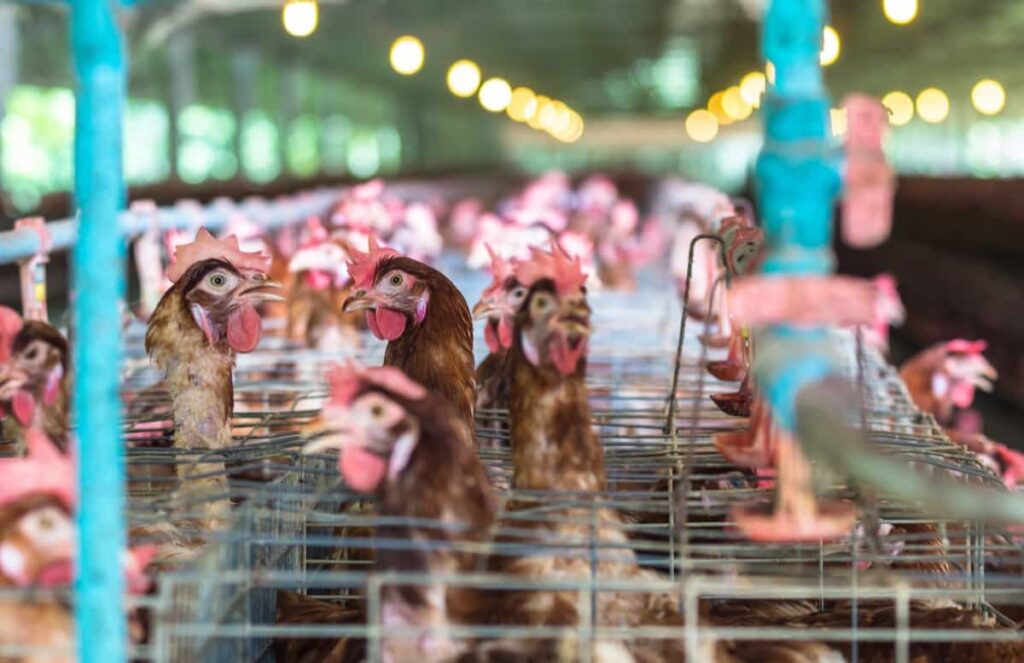
As a result, starting a chicken farm in India can be a lucrative business opportunity. Chicken farming requires careful management practices such as regular feeding schedules, disease prevention measures, monitoring growth rates, maintaining proper hygiene standards in housing areas, and implementing biosecurity protocols to prevent disease outbreaks among the flock.
Understanding the Poultry Farming Industry in India
Poultry farming has become a thriving industry in India, contributing significantly to the country’s economy. With an increasing demand for chicken meat and eggs, the poultry sector offers immense opportunities for entrepreneurs and farmers. The poultry industry in India is characterized by both small-scale backyard farms as well as large commercial operations. It employs millions of people across various stages of production, including breeding, hatching, rearing, and processing.
India ranks among the top egg-producing countries globally, with a vast network of hatcheries supplying farmers with high-quality baby chickens. The country also boasts advanced technology and infrastructure for efficient broiler production. Moreover, advancements in genetics have led to improved breeds of chickens that are disease-resistant and highly productive. These breeds yield better meat quality and ensure higher egg production rates.
Identifying Suitable Locations for Starting a Chicken Farm in India
It is crucial to the success of your poultry farming venture. Your chosen location can greatly impact your business’s profitability and sustainability. Consider the availability of land. A chicken farm requires ample space for housing, feed storage, and other facilities. Look for areas where land is affordable and easily accessible. Next, assess the climate conditions in different regions. Chickens thrive in moderate temperatures with adequate ventilation.
Avoid areas prone to extreme heat or cold, negatively affecting their health and productivity. Another important factor to consider is proximity to markets and suppliers. Choose a location that allows easy transportation of your products to customers while ensuring a reliable supply chain for sourcing feed and other essential materials. Additionally, check for any environmental restrictions or regulations specific to poultry farming in certain areas.
In case you missed it: 15 Best Electric Chicken Debeaking Machines: Price List Included
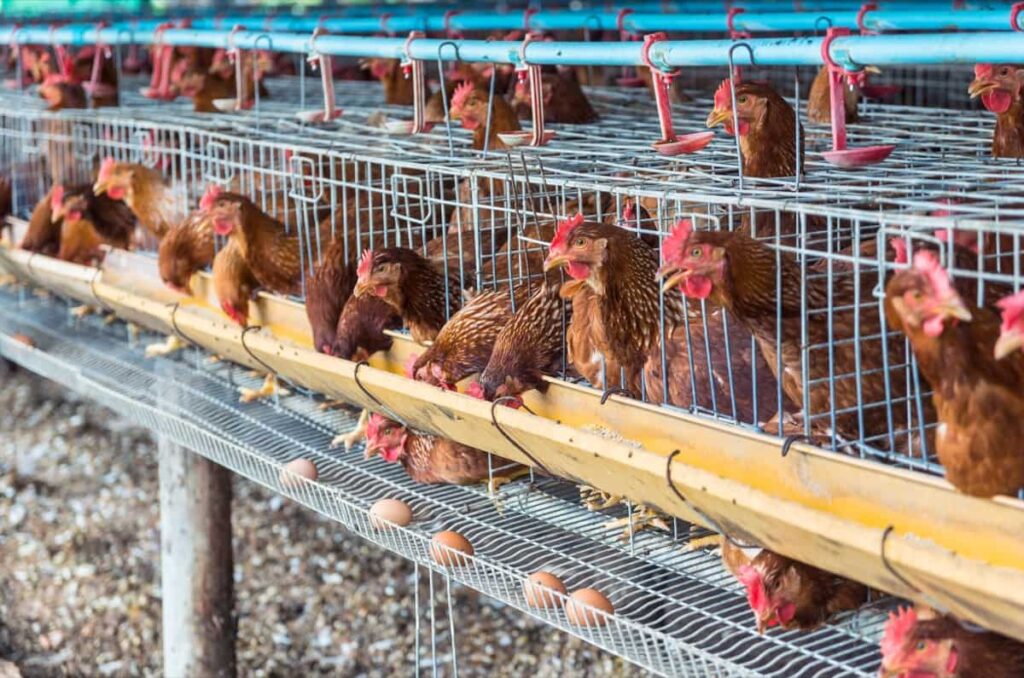
Acquiring the Necessary Licenses and Permits for Chicken Farming in India
To begin, you’ll need to obtain a registration certificate from the local authority or panchayat where your farm will be located. This certificate validates your business and allows you to operate legally. Next, you must apply for an NOC (No Objection Certificate) from the Pollution Control Board. This ensures that your farm meets environmental standards and does not pollute the surrounding areas.
Additionally, you’ll need to register under relevant acts such as the Prevention of Cruelty to Animals Act and various animal husbandry laws. These acts are in place to protect animal welfare and ensure ethical practices within the industry. It’s important to note that different states may have specific regulations, so it’s essential to research and understand these requirements based on your location.
Choosing the Right Breed of Chickens for Your Farm
It is a major decision that can greatly impact the success of your poultry business. With so many different breeds available, some factors such as egg production, meat quality, adaptability to local weather conditions, and disease resistance are important. One popular chicken breed for egg production is the White Leghorn. These chickens are known for their high egg-laying capacity and efficient feed conversion. They are small and require less space than other breeds, making them suitable for smaller-scale farms.
Rhode Island Reds or Plymouth Rocks could be good options if you’re looking for chickens with dual-purpose capabilities (both egg and meat production). These breeds are known for their hardiness and ability to withstand various climates. Broiler breeds like Cornish Cross or Cobb 500 are commonly chosen for those focusing on meat production. These birds grow quickly and have excellent feed conversion rates, resulting in larger-sized birds with tender meat.
It’s also important to consider the availability of these breeds in your area. Local indigenous breeds may be well-adapted to the local environment but may not offer as high productivity as commercial hybrid varieties. Choosing the right breed depends on your specific goals and available resources. Consulting with experienced farmers or poultry experts can provide valuable insights into which breed best suits your needs.
Setting Up the Infrastructure and Housing for Your Chicken Farm
The infrastructure includes buildings, equipment, and facilities that are essential for the proper functioning of your farm. You need to plan and design the layout of your chicken farm. This involves determining the number of houses or sheds you will need based on the size of your flock. It’s important to consider factors like ventilation, lighting, temperature control, and biosecurity measures while designing these structures.
Next, you must ensure adequate space for each bird inside the housing units. Overcrowding can lead to stress and diseases among chickens, so providing sufficient space per bird is essential. Additionally, you’ll need to set up feeding and watering systems within each housing unit. These systems should ensure easy access for chickens while minimizing wastage and contamination.
In case you missed it: 12 Best Chicken Pluckers: Defeathering Machine Price List Included
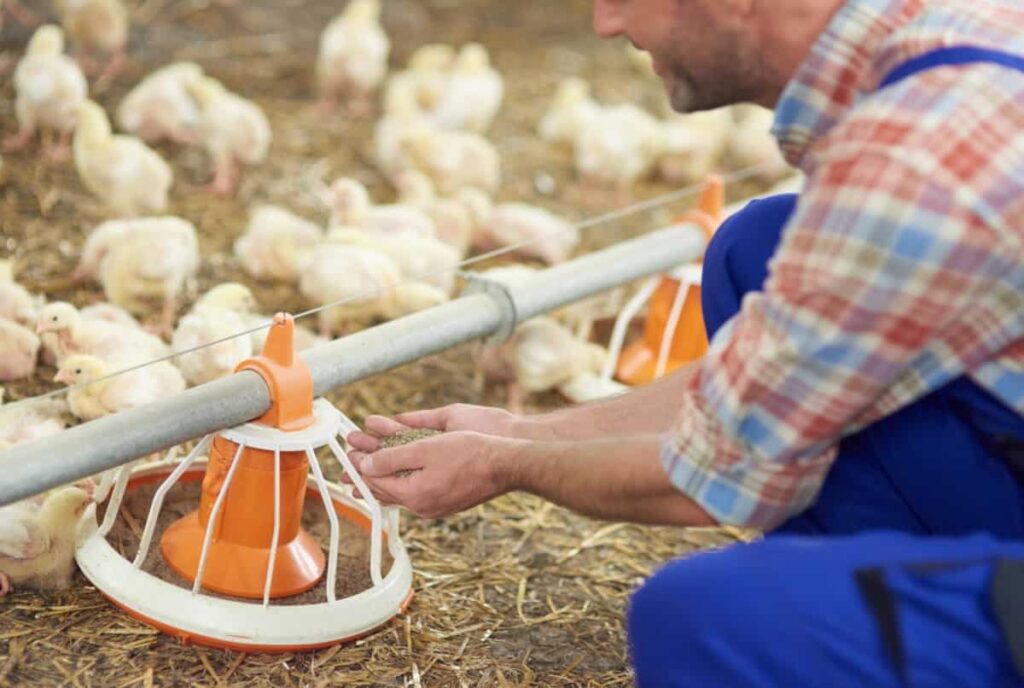
Proper waste management is also crucial in maintaining a healthy environment for your birds. You’ll need appropriate systems to handle manure disposal or recycling effectively. Investing in high-quality equipment such as feeders, drinkers, nest boxes, heating devices (if required), and lighting fixtures will significantly optimize your farm’s productivity.
Procuring High-Quality Baby Chickens or Eggs for Starting Your Flock
How would you select good-quality baby chickens? Select a reputable chicken supplier who can provide healthy and disease-free birds. Look for suppliers with a good track record and positive reviews from other poultry farmers. Decide whether you want to start with day-old baby chickens or prefer incubating eggs yourself. If opting for day-old baby chickens, ensure they are vaccinated against common diseases such as Newcastle disease and Marek’s disease.
When selecting eggs for hatching, ensure they come from healthy parent stock with good genetic traits. It is recommended to source fertilized eggs from reliable breeders who maintain proper breeding records. Consider the breed that suits your farming goals and market demand. Popular chicken breeds in India include Rhode Island Red, Kadaknath, Vanaraja, and Aseel. Choose breeds known for their productivity, adaptability to local conditions, and resistance to diseases in your area.
Implementing Proper Feeding and Nutrition Practices for Optimal Growth
A balanced feed diet that fulfills their nutritional requirements is essential for maximizing productivity and profitability in your poultry farm. Start by choosing the right feed formulation for chickens based on the age and purpose of your chickens. For example, starter feeds are designed for baby chickens, while grower or finisher feeds are suitable for older birds. These feeds should contain proteins, carbohydrates, fats, vitamins, minerals, and other essential nutrients.
Feeding schedules should be consistent to maintain regularity in their intake. Ensure that clean water is always available for your chickens, as it aids digestion and overall well-being. Supplementing their diet with additional protein sources, such as soybean meal, can enhance muscle development and egg production in layers. Additionally, calcium-rich supplements like oyster shells can promote strong eggshells in laying hens.
Monitor your chickens’ body condition score (BCS) regularly to assess if they are receiving adequate nutrition. Adjust feed quantities accordingly to prevent underfeeding or overfeeding, which can lead to growth issues or obesity-related problems. Regularly consult with veterinarians or poultry nutrition experts to stay updated on the research findings regarding optimal feeding practices. They can guide you on specific dietary needs during different stages of growth or address any nutritional deficiencies within your flock.
Managing The Health and Biosecurity of Your Chicken Flock
Proper disease prevention and control measures are essential to ensure your chickens remain healthy and productive. Regularly monitoring the health of your flock is important. Monitor for any signs of illness, such as decreased activity, loss of appetite, abnormal droppings, or respiratory issues.
In case you missed it: 15 Types of Black Chicken Breeds with Pictures: The Ultimate List for Your Backyard
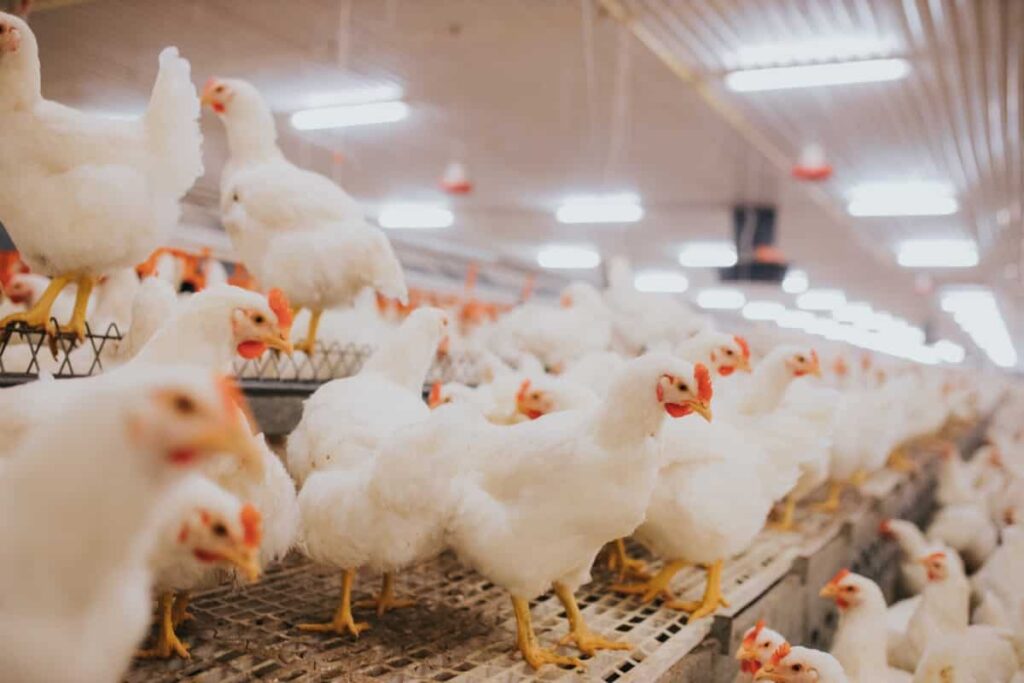
If you notice any abnormalities in chickens, consult a veterinarian immediately. What are the biosecurity rules for poultry farms? Maintaining strict biosecurity protocols is vital in preventing the introduction and spread of diseases within your farm. Limit access to outsiders, including vehicles and equipment from other farms. Disinfect all equipment entering or leaving the farm premises.
Vaccinations significantly prevent common poultry diseases such as Newcastle disease, Marek’s disease, and infectious bronchitis. Consult a veterinarian to develop an appropriate vaccination schedule for your flock based on their age and specific requirements. Regularly clean and disinfect housing areas, waterers, feeders, equipment, and tools used on the farm.
Understanding The Legal Requirements and Regulations for Poultry Waste Management
Poultry waste refers to the manure, feathers, bedding material, and other byproducts generated from raising chickens. Proper waste management is essential to minimize environmental pollution and ensure compliance with government regulations. In India, there are specific guidelines set by regulatory authorities that farmers must follow regarding poultry waste management.
These guidelines aim to protect the environment, public health, and animal welfare. They include proper storage, handling, transportation, treatment, and disposal of poultry waste. One important aspect of poultry waste management is maintaining clean and hygienic conditions within the farm premises. Regular cleaning of chicken houses and removal of accumulated waste should be done to prevent diseases and maintain a healthy flock.
Farmers must also implement proper methods for treating or utilizing poultry waste. This can include composting or using it as fertilizer after appropriate processing. It’s important to adhere to any local or state regulations related to these practices. Furthermore, chicken farmers in India need to stay updated on any changes in legislation or new requirements regarding poultry waste management.
Calculating The Initial Investment and Cost of Setting Up a Poultry Farm
For those planning to start a small-scale poultry farm in India, an investment ranging from INR 50,000 to INR 1,50,000 would be necessary. This includes expenses for building infrastructure, purchasing equipment, and supplies, and acquiring the initial flock. If you aspire to a medium-scale poultry business, you may need to budget around INR 1.5 lakh to INR 3.5 lakhs. This increased investment accounts for larger housing facilities and equipment requirements.
In case you missed it: Barred Rock Chicken/Plymouth Rock Chicken: Origin, Characteristics, Egg Production, Lifespan, and Temperament
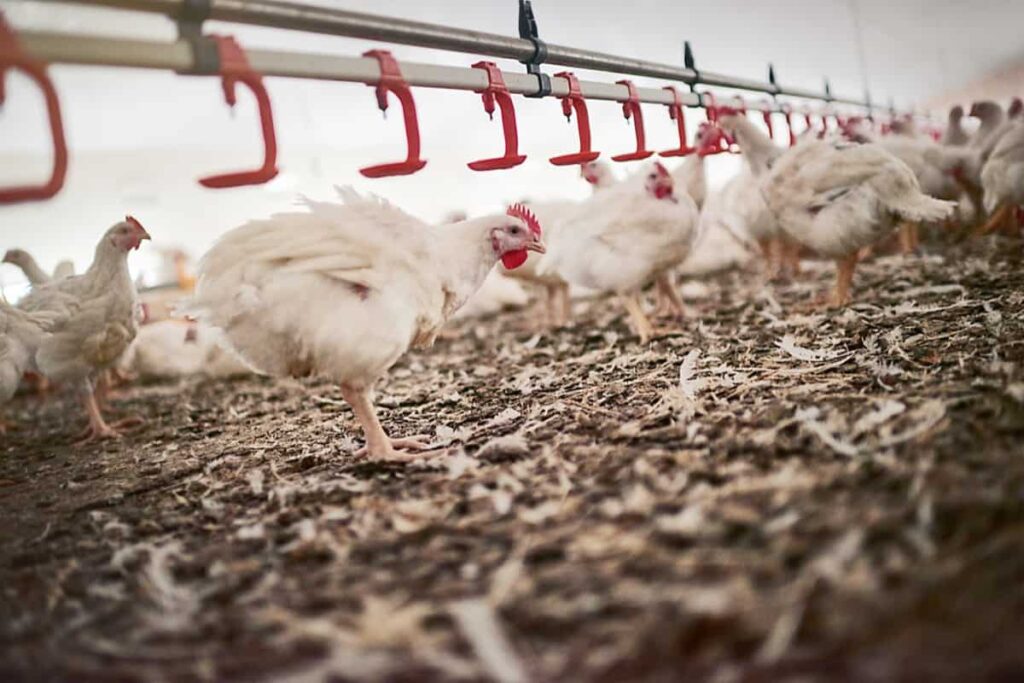
How much does it cost to start a poultry farm in India? For those aiming for a large-scale poultry farm with higher production capacity, investing between INR 7 Lakhs to INR 10 lakhs is recommended. Such investments are necessary due to the substantial costs of constructing larger infrastructure and procuring advanced machinery.
Starting a poultry farming business in India requires careful financial planning but offers potential returns on investment. With an initial capital ranging from Rs 2-3 lakhs and starting layer farming at a smaller level with around 1500 chickens, it could potentially yield monthly earnings between Rs 50,000 -1 lakh.
Researching The Market Demand for Chicken Products in India
To begin with, it’s important to analyze the consumption patterns of chicken products in different regions of India. This will give you insights into areas with a higher demand for poultry products and where there might be untapped markets. Conducting surveys with potential customers such as restaurants, hotels, supermarkets, and individual consumers can provide valuable information about their preferences and requirements when purchasing chicken products.
Market research also involves studying the competition – other poultry farms or suppliers already operating in your target market. Furthermore, keeping track of industry reports and news updates on factors like government policies related to poultry farming or changes in consumer behavior will help you stay ahead of any shifts in the market dynamics.
Establishing Partnerships with Suppliers, Distributors, and Retailers in The Poultry Industry
When choosing suppliers, look for ones that offer high-quality feed, medication, and other necessary inputs for poultry farming. Building good relationships with reliable suppliers will ensure a steady supply of essential resources for your farm. Similarly, collaborating with distributors with a wide reach and experience in the poultry industry can help you expand your market presence.
Distributors are vital in getting your products to different retail outlets across India. Retailers are the final link between you as a farmer and consumers. Partnering with reputable retailers prioritizing quality and customer satisfaction will enhance your brand reputation and increase consumer trust in your chicken products.
To establish these partnerships effectively, attend industry trade shows where you can network with potential partners. Build relationships based on mutual trust, transparency, and shared goals. Regular communication is key to maintaining strong partnerships. Stay informed about market trends, changes in demand patterns, or any challenges faced by your partners so that you can provide support when needed.
Continuously Learning and Staying Updated on Advancements in Poultry Farming Practices
By keeping up with advancements in poultry farming practices, you can improve your farm operations’ efficiency, enhance your flock’s health and productivity, reduce costs, and maximize profits. Whether adopting new feeding techniques or implementing innovative biosecurity measures, staying updated will give you an edge over competitors.
In case you missed it: How to Build Chicken Run in Your Budget: Cheap and Low-cost Ideas for Your Chicken Coop
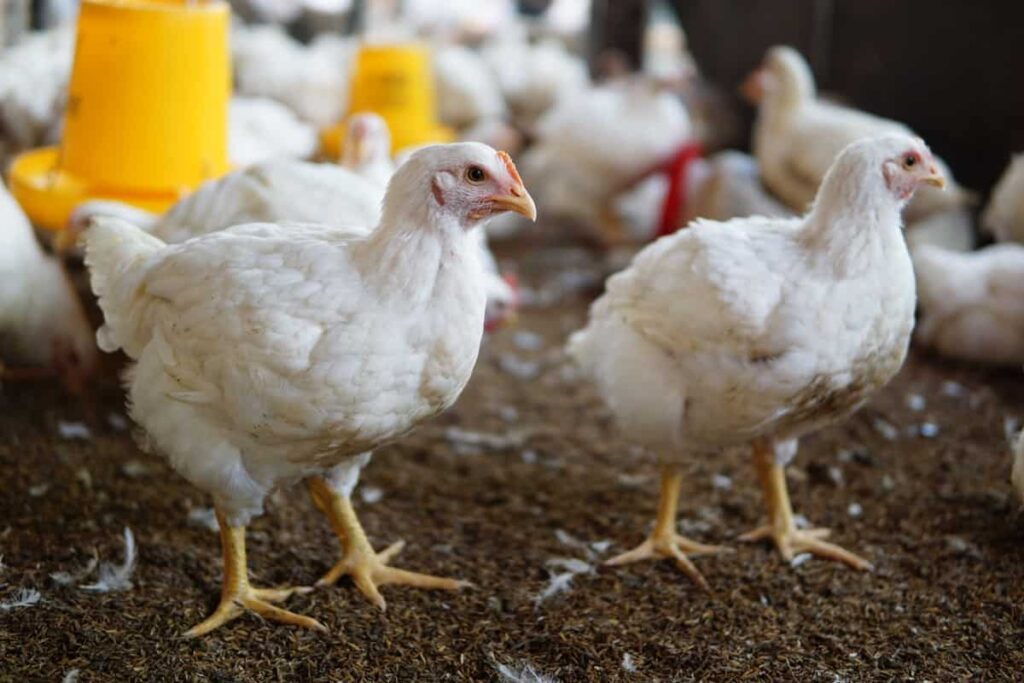
One way to stay informed is by attending workshops, seminars, or conferences related to poultry farming. These events provide opportunities for networking with industry experts while gaining valuable insights into emerging trends and technologies. These events provide opportunities for networking with industry experts while gaining valuable insights into emerging trends and technologies. Is chicken farming profitable in India?
With subsidies, you can start a profitable poultry farming business in India. Additionally, subscribing to credible agricultural magazines or joining online forums dedicated to poultry farming can keep you abreast of the latest news and discussions within the industry. Engaging with other farmers through these platforms allows for knowledge-sharing experiences that can help overcome challenges fellow chicken farmers face.
Chicken Farming in India: State-wise Production
| State/UT | Chicken Production (in tonnes) |
| Andhra Pradesh | 200,000 |
| Arunachal Pradesh | 15,000 |
| Assam | 90,000 |
| Bihar | 120,000 |
| Chhattisgarh | 80,000 |
| Goa | 6,000 |
| Gujarat | 110,000 |
| Haryana | 75,000 |
| Himachal Pradesh | 18,000 |
| Jharkhand | 70,000 |
| Karnataka | 140,000 |
| Kerala | 85,000 |
| Madhya Pradesh | 110,000 |
| Maharashtra | 135,000 |
| Manipur | 12,000 |
| Meghalaya | 13,000 |
| Mizoram | 9,000 |
| Nagaland | 11,000 |
| Odisha | 95,000 |
| Punjab | 80,000 |
| Rajasthan | 95,000 |
| Sikkim | 4,000 |
| Tamil Nadu | 175,000 |
| Telangana | 180,000 |
| Tripura | 21,000 |
| Uttar Pradesh | 150,000 |
| Uttarakhand | 25,000 |
| West Bengal | 110,000 |
| Andaman & Nicobar | 2,000 |
Conclusion
Farmers breed and raise chickens in controlled environments called chicken farms or poultry houses in chicken farming. These facilities are designed to provide optimal living conditions for the birds while ensuring their health and well-being. The primary purpose of chicken farming is to produce eggs or meat (broilers) commercially. Layer farms mainly focus on egg production, while broiler farms primarily rear chickens specifically bred for meat consumption.
- Broccoli Varieties: Choosing the Right Cultivars for Your Farm
- How to Raise Pigs in Your Own Backyard: A Comprehensive Guide
- Budget Friendly Sheep Shed Ideas: Cheap and Low-Cost Tips
- How Much Do Cattle Farmers Make: Revenue Streams in Cattle Farming
- Management Pests and Diseases in Your Cotton Field
- Sheep Farming Business Plan for Beginners
- Aquaponic Farming at Home: A Step-By-Step Guide
- Profitable Village Farming Business Ideas in 2024
- High-Yield Aquaculture: Fast-Growing Fish for Farming
- Effective Fish Pond Construction Techniques for Beginners
- Irrigation and Water Management in Pineapple Farming
- Blossom to Harvest: Mastering Flowering and Pollination in Papaya Farming
- Pig Fattening Essentials: From Selection to Sale for Beginners
- Raising Wagyu Cattle: A Complete Guide for Premium Beef Production
- Soil Types and Their Water Holding Capacity
- Optimizing Irrigation Schedules for Coconut Groves for Enhanced Yield
- Espresso Your Garden: Coffee Grounds for Healthier Acid-Loving Plants
- The Best Soil Mix for Snake Plants: How to Mix Your Own Snake Plant Soil
- Green Thumb Success: Expert Tips for Cultivating Greenhouse Beans All Year Round
- Bloom All Year Round: The Ultimate Guide to Indoor Hyacinth Care
- Eco-Friendly Gardening: How to Make Liquid Fertilizer from Kitchen Waste
- Ultimate Guide to Grow Anise in Pots: Explore Seed Propagation to Harvesting
- Guide to Raising Chester White Pigs: Discover Breed Facts to Growth Management
- Mastering the Elegance: The Ultimate Guide to Weeping Cherry Tree Care, Planting, and Maintenance
- Ultimate Guide to Planting Garlic in Grow Bags: Growing Strategies for Beginners
- How to Fix Spider Plant Leaf-Related Problems: Natural and Organic Remedies
- 10 Reasons Why Your Tulsi Plant is Shedding Leaves: Home Remedies and Solutions
- Optimizing Growth and Yield: The Advantages of Palm Bunch Ash Fertilizer
- Utilizing Neem Oil Extract as a Natural Pesticide for Hydrangea
- From Soil to Harvest: Various Ways in Which Farmers Can Use AI Tools
- Steps to Encourage and Induce Citrus Flowers: A Comprehensive Guide
- How to Fix Snake Plant Leaf-Related Issues: Natural and Organic Remedies
- Transform Your Garden into a Fragrant Oasis with Raat Ki Rani (Night Blooming Jasmine)
- Discover the Ideal Chicken Breeds for Philippine Farms
- How to Create a Poultry Egg Farm Business Plan for Profits
- Grow Lemon Cucumbers Like a Pro: Insider Techniques for Bountiful Yields
